Racism
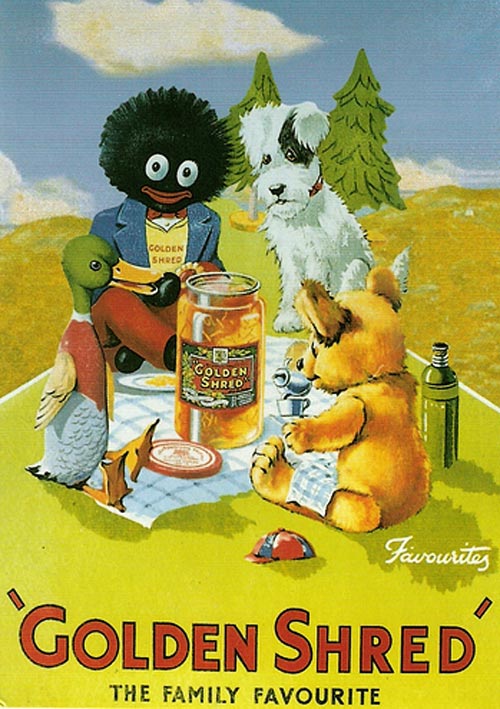
This marmelade ad from 1910 shows amongst others, a golliwog. I've never seen one in my lifetime, but, to my surprise, they are apparently still for sale in some countries. While they are quite grotesque stereotypes of africans, I suppose their cutesy, innocent qualities makes up for it in the eyes of some.
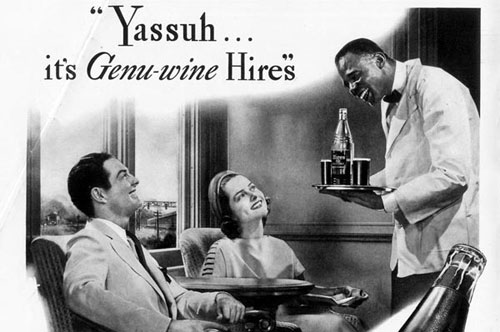
A classic take on the classic stereotype of the black servant (or slave?) happily serving his massa, complete with the correct lingo.
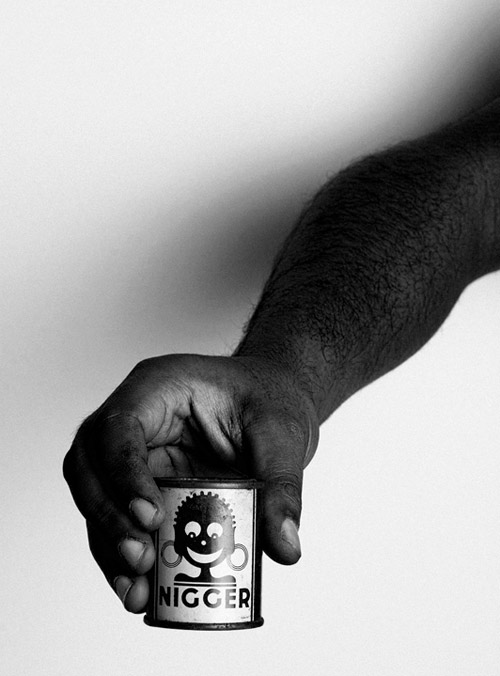
No fuss, to the point racist packaging. What you see here is an old Norwegian brand of tar/varnish used on wood burning ovens. It's been out of production for a good while now, (I wonder why?) but boxes like this can still be found tucked away in old dusty closets in Norway.
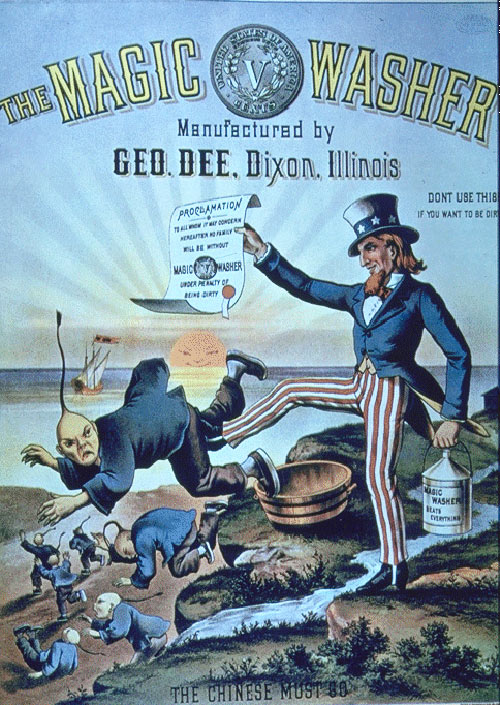
With the combination of the Uncle Sam figure and the proclamation in his hand, its reasonable to suspect that this 1882 advert is a kind of weird play on the Chinese Exclusion Act which was passed as US law that same year. Combining advertisement for some sort of detergent or washing machine with the slogan "The Chinese must go" seems sort of irrelevant to me, but since anti-Chinese animosity was significant at the time, it certainly hit home amongst potential customers, regardless of actual relevance.
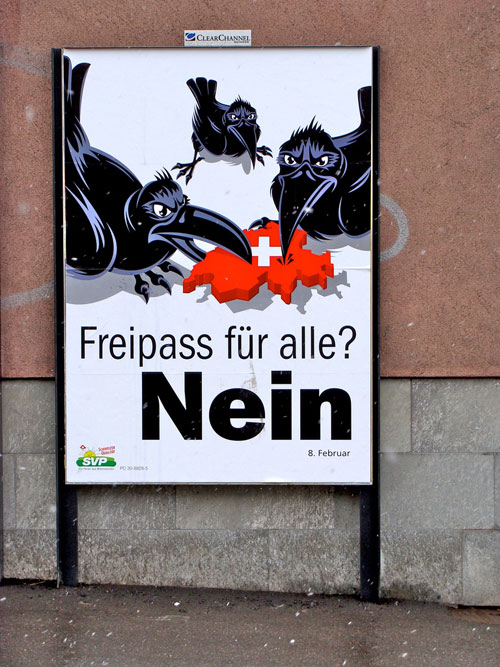
More than a century later, in 2007, we find these somewhat less explicit posters in Switzerland, promoting the right wing Swiss People's Party (SVP) and various supported initiatives. This poster roughly translates as "Free pass for all? NO". The issue at hand was a vote on the 8th of February on whether the country should carry on its policy of mutual open labour markets with the European Union, and also extend this to new EU members Bulgaria and Romania.
Naturally, the birds trying to get a bite out of Switzerland aren't white doves or owls, they're crows, black as the night, with obvious symbolism. In any case, the SVPs campaign failed and the policy of open labour markets was extended.
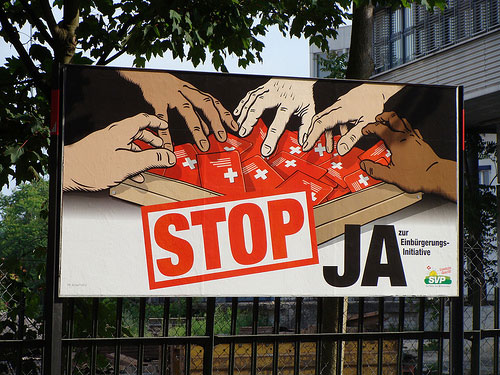
In 2004, the same SVP had success in restricting the naturalization laws for prospective new Swiss citizens, something which the party campaigned for again last year. Both times, this illustration was used on posters, showing thieving hands of many skin colours reaching into a pile of Swiss passports. Swiss naturalization laws are already among the strictest in the world.
Cigarettes
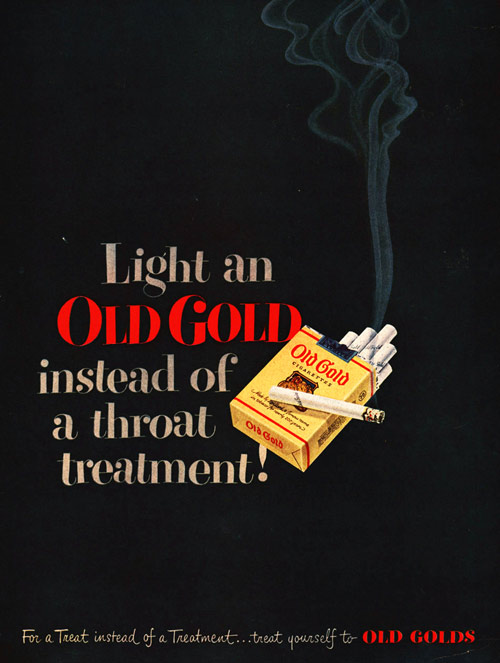
I think anyone who's ever inhaled a puff of cigarette smoke could see the irony in recommending smoking as a treatment for a sore throat. Still, these adverts where abundant.
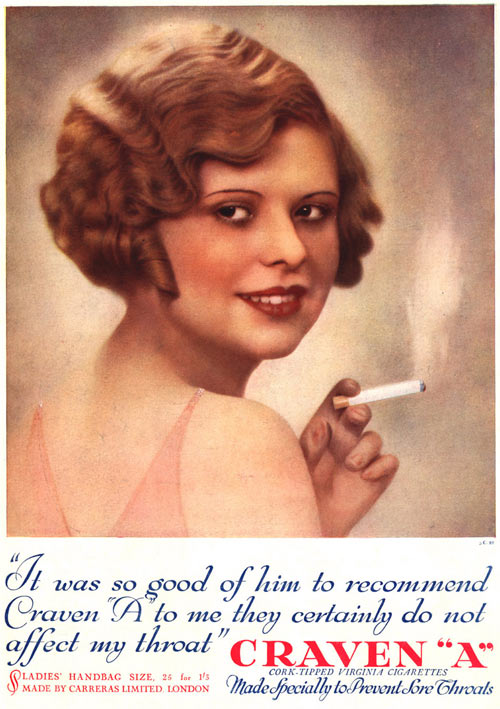
Certainly not! After all, it's "Made specially to prevent sore throats". The nicotine and smoke are just side effects I suppose.

This medicinal cigarette, not recommended for children under 6, apparently treats many ailments usually thought to be caused by cigarettes, like asthma, foul breath and bronchial irritations. Well done Dr. Batty!
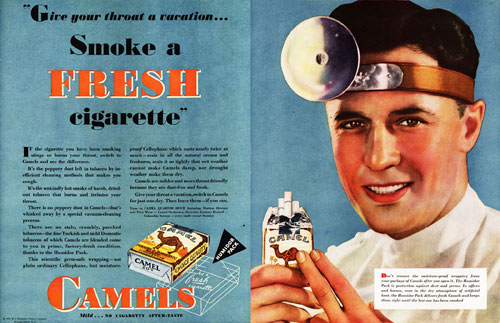
If the mustached Dr. Batty couldn't convince you of the positive effects of smoking, this fresh pumpkin of a doctor should certainly do the trick. According to this advert, "It's the peppery dust left in tobacco by inefficient cleaning methods that makes you cough". You may not be able to read it at this size, the text under the logo reads "Mild... No cigaretty after-taste".
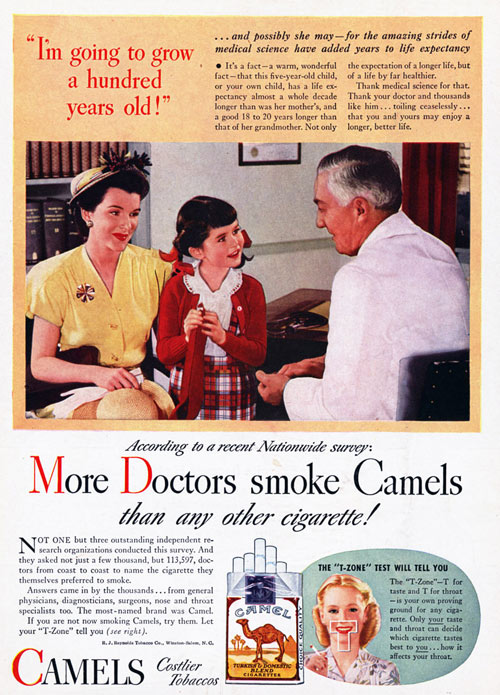
This ad is mix of two completely different topics. At the top, the little girl is seen telling her doctor she'll live to be a hundred, and the text more or less confirms this, thanks to rapid progress of medical science and hard working doctors putting that science to use. In the lower half, Camel claims that a survey among 113 597 doctors brought back Camel as the favourite brand.
Mixing these two completely different topics coincidentally leaves the happy impression that there's no contradiction between smoking camels and living to be 100 years old.
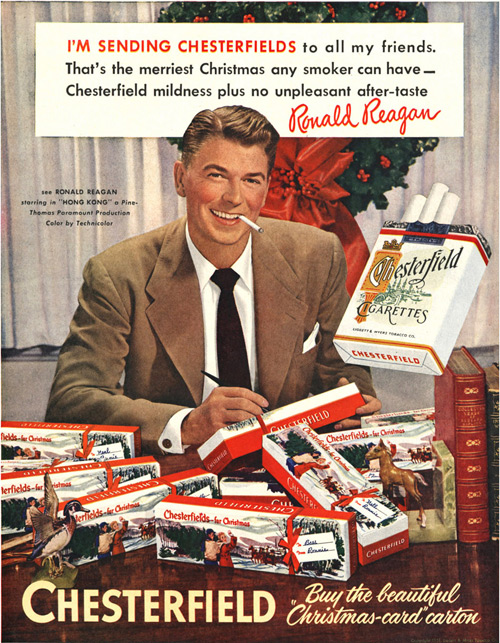
I'm not sure exactly when the public opinion on the health effects of smoking started turning decidedly towards the negative. Nor am I an expert on US politics. That said, I'm fairly certain that had Barack Obama appeared endorsing cigarette cartons as merry Christmas gifts, it would have had a negative effect on his electoral support.
But in 1951, smoking was still fine and dandy, and it would be another 30 years before the young actor Ronald Reagan would assume the presidency of the United States.
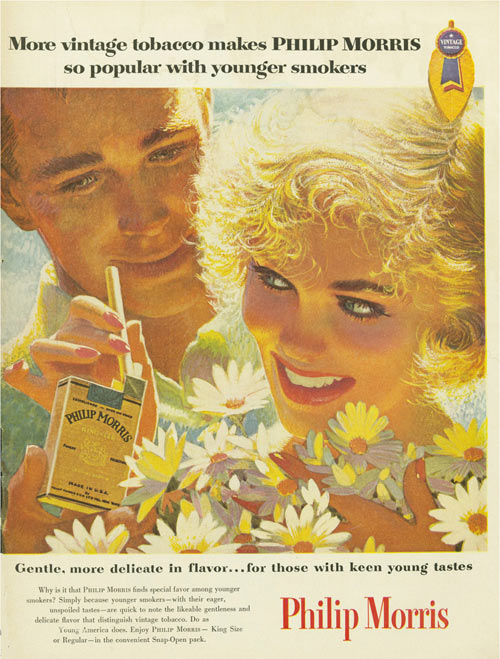
In recent years, there's been a lot of controversy over tobacco advertising aimed at a young (even underaged) demographic. Certainly, in the long run, it makes commercial sense for a brand to build a following among young people and consolidate their brand allegiance, since there are more years of sales to gain than with older people.
Mixing this bright, young and beautiful couple with fresh flowers and cigarettes certainly does a nice job at cleaning up the image of cigarette smoking.
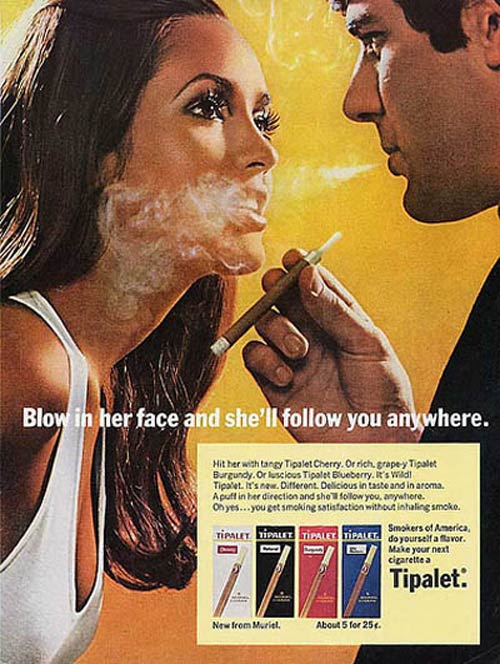
I wasn't quite sure whether this belonged more in the cigarette category or in the category below. I guess it's hard to make a solid claim to this being sexist, but no girl I know would go crazy about me for blowing smoke in her face. Even if the smoke is, for these cigarettes, cherry, burgundy or blueberry scented.
Sexism, misogynism and misandry
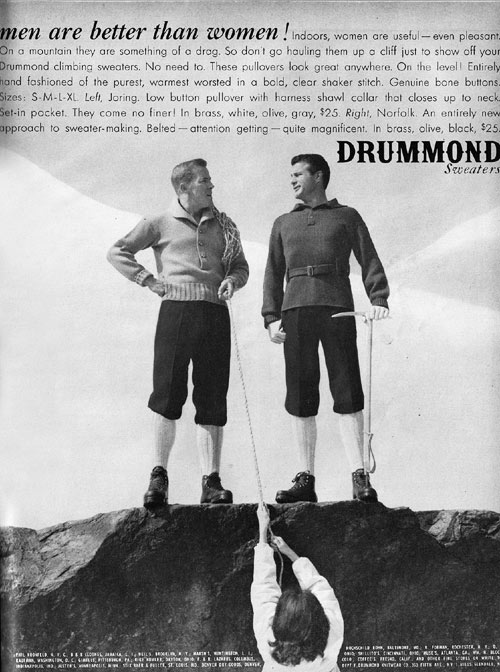 From this Vintage Advertising flickr set
From this Vintage Advertising flickr set "Men are better than women! Indoors, women are useful, even pleasant". At first, second and third glance, I was just delighting in the clear, straight forward quality of those initial words. It took a good while until I looked at the nether regions of the ad, for the demonstration of how little use women are outdoors.
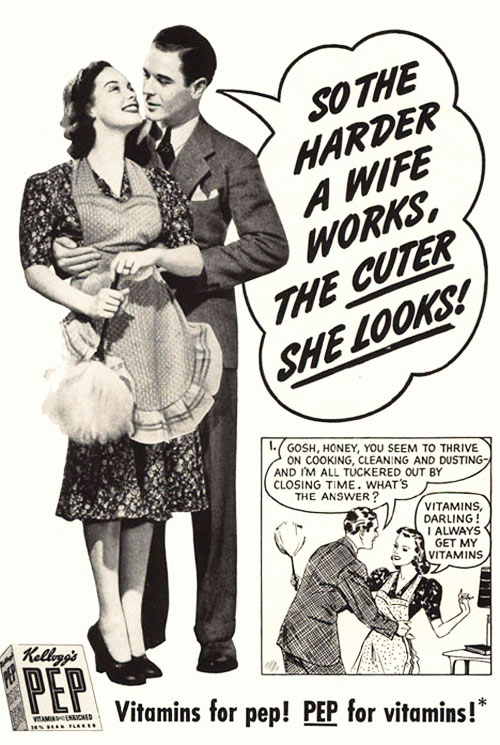
"Gosh honey, you seem to thrive on cooking, cleaning and dusting". Classic stuff, apron, feather duster and all.
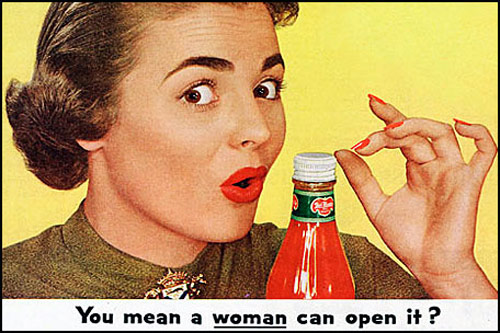
The wonders of modern technology! According to this Delmonte Ketchup advert, by 1953, bottle design had come so far even women could manage opening their Ketchup bottles.

I love these ads that state their (nowadays) politically incorrect messages as clearly as possible. According to this 1961 Kenwood ad, wives are for cooking.

From the outset, this ad leaves no doubt that this is a man's car, a strong, bullriding, cowboy man's car. A cowboy who likes to ride out into the wild and catch a nice, energetic woman to ride in. Hee-haw!
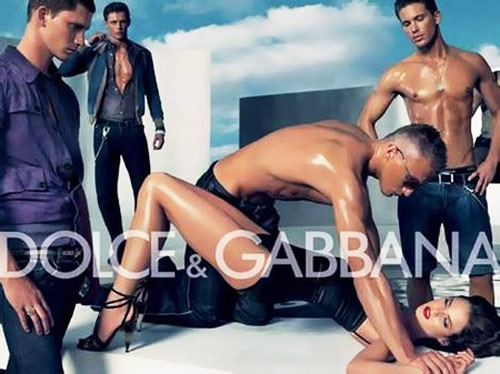

I've never pretended to understand high fashion. I'm more in tune with the street styles I've seen Amsterdam than with high fashion as seen in Paris or Milan. Maybe that's why I have a hard time grasping how glossy depictions of gang rape is going to help a brand sell.
Violence, vodka, death and divorce
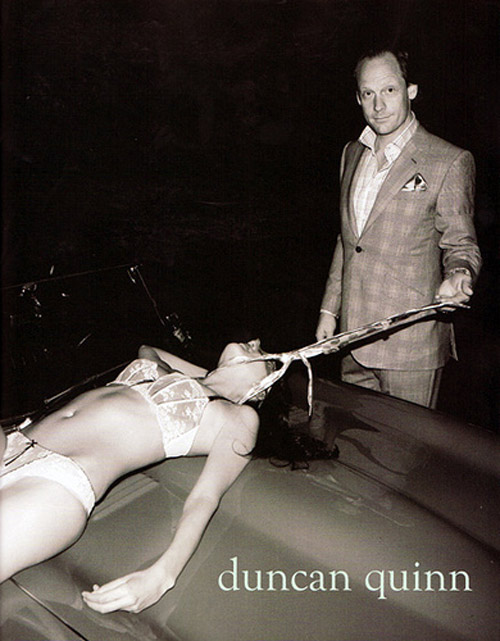
Seemingly trying to one-up Dolce & Gabbana, Duncan Quinn likes their brand to be associated with murderers, real stone cold killers by the looks of it.
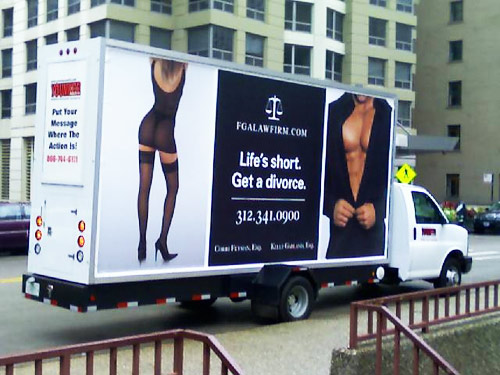
With divorce rates as high as they are in Norway (and in the US where this ad comes from, unsurprisingly), I guess I should be OK with this ad, but I'm having a hard time. Even if it's humorous, there's of course certain bit of truth in this ad. Trying to increase earnings by advertising divorce, something which few if any people or cultures in the world consider to be positive thing, well, that just seems like a crappy way of making money.
Chicago lawyers Fetman, Garland & Associates seem to thrive on the press generated by these campaigns, they've even set up a merchandise shop selling some real sorry clothes capitalizing on the campaign's slogans. By the way, the buttocks to the left belong to none other than the lawyer Corri D. Fetman, a former Playboy playmate.
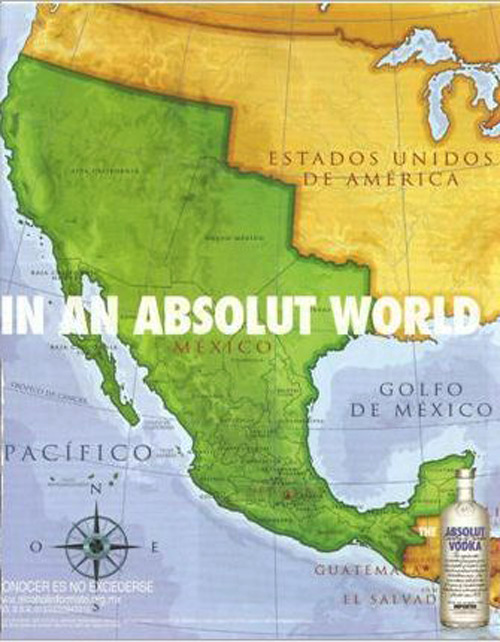
I could see how these ads, displayed in Mexico City, might cause a stir in the US. Swedish vodka brand Absolut apparently regards itself as competent of suggesting some bold territorial changes between these two countries, which have certainly seen their fair share of warfare. Luckily for Absolut, that's all in the past, there aren't a lot of people left alive with painful memories of the Mexican-American war of the 1840s.

Unlike the D&G ads shown earlier, Benetton doesn't try glamming up violent or otherwise crappy situations. While the motives for their campaigns including dying AIDS patients and soldiers, or campaigns such as this can rightly be questioned, in light of the D&G stuff above, I feel sort of OK with their stuff. Apart from the utter fakeness seen in most advertising, it's sort of refreshing to see a different angle, even if it's not the most pleasant material.

Never mind Benetton using dying people in advertising, Dr. Martens prefer those who have long since passed. For those who do not recognize the face, this is Kurt Cobain of legendary grunge rock band Nirvana, who killed himself with a shotgun in 1994. Even disregarding that his death was a suicide (though some alternate theories have arisen) which tends to make matters even morse sensitive, using dead people to endorse your products is cheating, pure and simple.

One of those ads that where fine and dandy when they where launched, but are pretty outrageous in hindsight. The keywords here are "Bhopal" and "1984". We are talking about one of the worst industrial disasters in history, killing something like 16 000 people in the Indian city of Bhopal where Union Carbide had a pesticide plant. This 1962 image of a big Union Carbide hand seemingly pouring chemicals straight out into free air is particularly poignant.
Of course there are many, many more examples of rather offensive or otherwise politically incorrect advertising. Perhaps you have some examples of your own? Please do share in the comments below!
Related Posts
» The Evolution of Propaganda Design: US Retro Posters » Propaganda Design & Aesthetics: Soviet Retro Posters» German Propaganda Posters from the 20th Century» Design Tutorial: Creating a Propaganda Poster